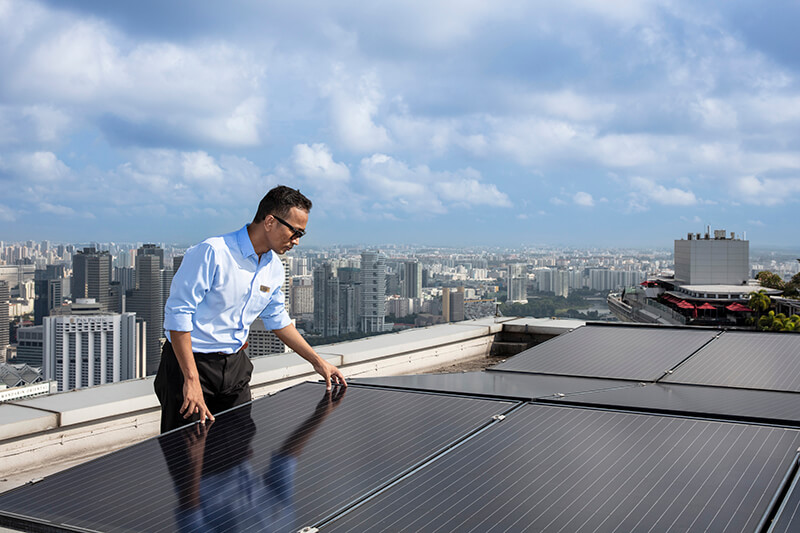News | November 13, 2024
Chasing Carbon Emissions Reductions: Sands Executes Three-Part Strategy for Success
In 2021, Sands set a target to reduce carbon emissions by 17.5% from a 2018 base year during its 2021-2025 environmental, social and governance reporting cycle. Over these years, the pandemic caused tremendous fluctuations in performance based on hampered resort visitation followed by normal business return. Despite the volatility, the company’s carbon emissions-reductions initiatives remained stable.
As of the end of 2023, Sands’ carbon emissions-reduction performance was 50% below the base year, despite resort visitation returning to pre-pandemic levels, driving energy consumption increases.
This success reflects the company’s long-term commitment to low-carbon transition. Sands was the first integrated resort company to set an emissions-reduction target validated by Science Based Targets initiative (SBTi), a corporate climate action organization. Since then, Sands has disclosed its performance through annual ESG reports, the S&P Global Corporate Sustainability Assessment (CSA), CDP Climate, the TCFD Index and most recently, a standalone low-carbon transition plan and performance overview published in summer 2024.
“We have achieved significant progress in reducing emissions by consistently working to improve performance by leveraging our Sands ECOTracker to identify and optimize projects across our global resorts,” Katarina Tesarova, senior vice president and chief sustainability officer, said. “With a firm commitment and ongoing diligence, we intend to make ongoing advancements and find new ways to reduce our carbon footprint.”

Energy Efficiency
Sands designs its buildings to conserve electricity and deploys new solutions and technologies to reduce energy consumption during ongoing operations. The company’s resorts employ building management systems to manage performance in airflow, electricity, plumbing and lighting. By integrating these areas into a central control system and incorporating intelligence capabilities, properties can simultaneously improve energy efficiency, optimize resource use and ensure guest comfort.
Thanks to efficiencies achieved in design and operations, several of the company’s building have received green building certifications, including LEED Platinum for Building Operations and Maintenance for the ArtScience Museum at Marina Bay Sands (2024), LEED Gold for Building Design and Construction for the corporate headquarters campus (2023), LEED Platinum for Building Operations and Maintenance for the Sands Expo and Convention Centre at Marina Bay Sands (since 2019), and LEED Silver for Building Design and Construction for The Parisian Macao (2019).
The Sands ECOTracker provides a framework for planning capital expenditures, managing energy efficiency projects and defining pathways for investments in innovative solutions. The program led to savings of 14,722 megawatt hours of electricity globally in 2023.

Renewable Energy
Complementing its energy efficiency strategies, Sands also employs renewable energy solutions, including on-site solar thermal and solar photovoltaic systems and purchases of renewable energy certificates as part of its total energy mix. In 2023, Sands generated 1,300 megawatt hours of renewable energy through its internal sources, which include Marina Bay Sands’ rooftop solar system, Sands China’s solar thermal system and the solar photovoltaic system at the company’s headquarters campus in Las Vegas, Nevada.
In addition, Sands procured 285,000 megawatt hours of renewable energy certificates last year, resulting in 22% of global energy sourced from renewable sources.
Transportation
Sands’ primary initiatives in pursuing sustainable transportation solutions include electrifying equipment and transitioning guest shuttle and Team Member commuter buses to electric and alternative fuel sources, along with purchasing carbon offsets to address hard-to-decarbonize air and ferry travel. Sands has consistently expanded the electric vehicle charging infrastructure at its resorts and corporate campus to accommodate guest and Team Member adoption of electric vehicles.
Supplementing these three components, Sands provides training and communication on energy efficiency, renewable energy procurement and innovative trends in building and design to its facilities, engineering, procurement, and design and development departments. This guidance helps departments understand their connection to the company’s low-carbon transition strategy and how they can impact achievement of the company’s emissions-reduction ambition.
Sands’ efforts to reduce carbon emissions are a key priority under the Planet pillar of its corporate responsibility platform and led by the Sands ECO360 global sustainability program. To learn more, read the company’s Low-Carbon Transition Plan: https://www.sands.com/resources/reports/.